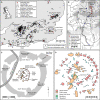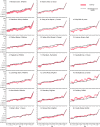Origins of the sarsen megaliths at Stonehenge
- PMID: 32832694
- PMCID: PMC7439454
- DOI: 10.1126/sciadv.abc0133
Origins of the sarsen megaliths at Stonehenge
Abstract
The sources of the stone used to construct Stonehenge around 2500 BCE have been debated for over four centuries. The smaller "bluestones" near the center of the monument have been traced to Wales, but the origins of the sarsen (silcrete) megaliths that form the primary architecture of Stonehenge remain unknown. Here, we use geochemical data to show that 50 of the 52 sarsens at the monument share a consistent chemistry and, by inference, originated from a common source area. We then compare the geochemical signature of a core extracted from Stone 58 at Stonehenge with equivalent data for sarsens from across southern Britain. From this, we identify West Woods, Wiltshire, 25 km north of Stonehenge, as the most probable source area for the majority of sarsens at the monument.
Copyright © 2020 The Authors, some rights reserved; exclusive licensee American Association for the Advancement of Science. No claim to original U.S. Government Works. Distributed under a Creative Commons Attribution NonCommercial License 4.0 (CC BY-NC).
Figures



References
-
- W. Lambarde, Dictionarium Angliae Topographicum et Historicum: An Alphabetical Description of the Chief Places in England and Wales; with an Account of the Most Memorable Events Which Have Distinguish’d Them (F. Gyles, London, 1730).
-
- W. Stukeley, Stonehenge a Temple Restr’d to the British Druids (W. Innys and R. Manby, London, 1740).
-
- Gowland W., Judd J. W., III.—Recent excavations at Stonehenge. Archaeologia 58, 37–118 (1902).
-
- Thomas H. H., The source of the stones of Stonehenge. Antiquaries J. 3, 239–260 (1923).
-
- Hill P. A., The sarsens of Stonehenge: The problem of their transportation. Geogr. J. 127, 488–492 (1961).
Publication types
LinkOut - more resources
Full Text Sources

